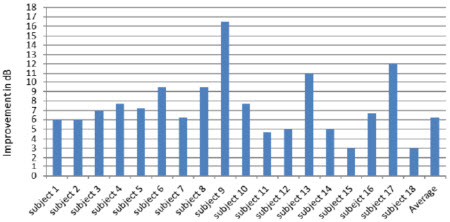Question
What technology can help children who use cochlear implants to hear in noisy classrooms?
Answer
Bradley and Sato (2004) studied speech understanding in school-age children in real world environments. They found that the ability to hear in noise improves as children get older, with younger children needing higher signal-to-noise ratios (SNR) to achieve the same performance as older children. For example, first grade students required, on average, 7 dB better SNR than students in sixth grade to score 95% on a word recognition task. The study also looked at the average SNR in classrooms and concluded that the acoustical conditions in typical classrooms are not ideal for understanding the teacher, especially for younger children. The study considered only children with normal hearing. For a child with a hearing loss, being able to follow spoken instructions in a school environment is more challenging, even when they are using hearing aids, bone anchored hearing aids or cochlear implants. While these devices may provide adequate amplification, they do not improve SNR. Children with hearing loss need an optimal signal-to-noise ratio to maximize learning and academic potential.
The easiest way of improving SNR is for the listener to move closer to the desired sound source. Moving from 4 meters distance to 1 meter can improve the SNR up to 12 dB. However, moving closer to the sound source is not always possible or convenient.
Moving closer to the sound source can be achieved technically using a near field microphone from Comfort Audio. A near field microphone is placed 30 to 40 cm from the desired sound source, commonly fitted as a lapel or attached to a boom. Near field microphones from Comfort Audio have a built-in antenna and therefore external microphones are not needed.
A recent study (Billups, & Verhoff, 2012) investigated SNR with 18 children ages 5 to 10 years old, who used cochlear implants (CI). The study examined the difference in SNR using the CI alone compared with the CI used in combination with the Comfort Digisystem (Comfort Digisystem Receiver DT10, mini receiver connected directly to the CI processor, and Comfort Digisystem Microphone DM10, a near field microphone).
Overall results as shown in Figures 1 and 2 indicated that many of the children comprehended well in noise using their CI alone, with results similar to a mild to moderate hearing loss. However, all children benefited from an improvement in SNR using the Comfort Digisystem. Individual improvement varied between 3 dB and 16.5 dB, with an average improvement of 6 dB.
c
Figure 1. SNR needed to achieve 50% speech intelligibility using cochlear implant alone (blue) and cochlear implants in combination with Comfort Digisystem (red) for 18 subjects.

Figure 2. Improvement in SNR (in dB) using cochlear implant in combination with Comfort Digisystem over using the cochlear implant alone for 18 subjects. Average improvement is 6.2 dB.
Using Comfort Digisystem together with a cochlear implant can give children better speech understanding in noisy environments, like classrooms, by improving the signal-to-noise ratio. Combining a cochlear implant with Comfort Digisystem supports learning and academic success. For more information about Comfort Audio and Comfort Digisystem, please visit www.comfortaudio.com/us or the Comfort Audio Expo Page on AudiologyOnline.
References
Bradley, J.S., & Sato, H. (2004). Speech recognition by grades 1, 3 and 6 children in classrooms. Canadian Acoustics, 32(3), 26 – 27.
Verhoff, J., & Billups, K. (2012, November). Speech recognition in children with CIs with digital radio technology. Poster presentation at ASHA convention, Atlanta, GA.

